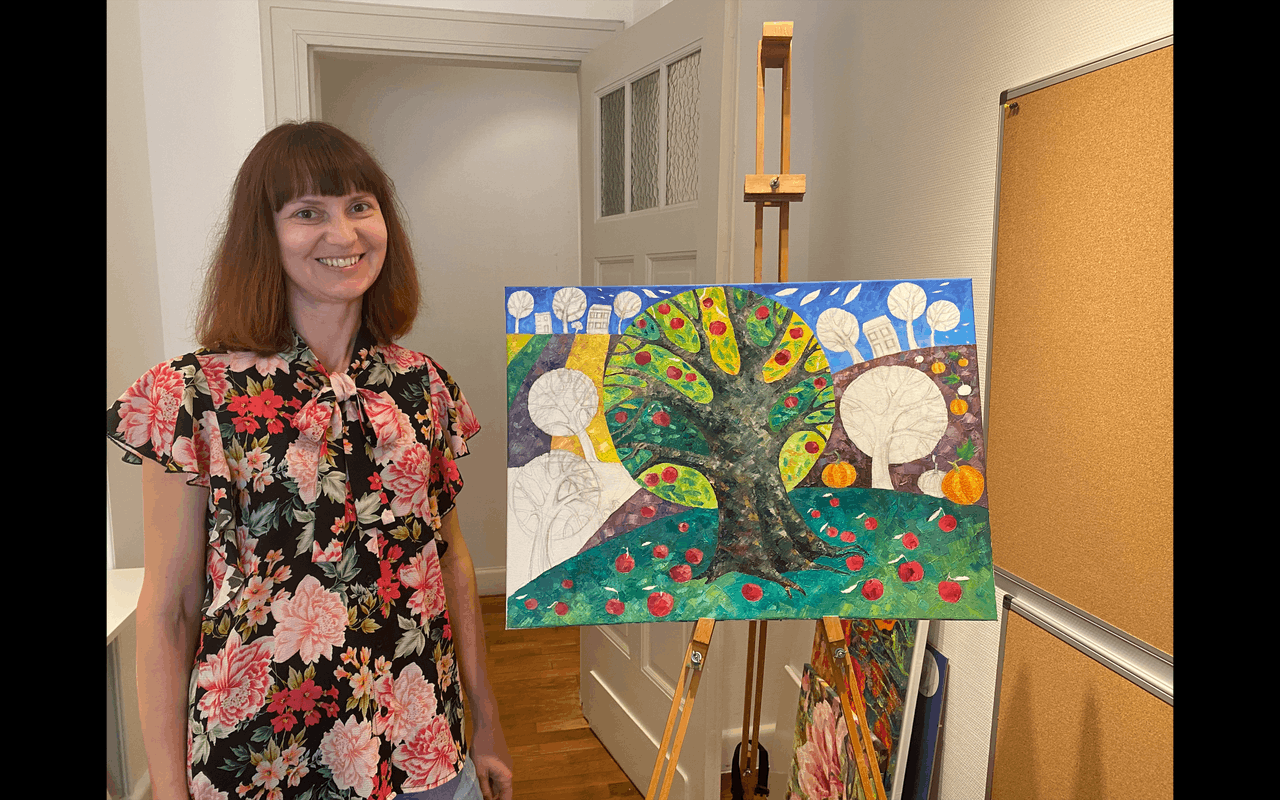When did you arrive in Luxembourg?
I remember the dates very well. It’s been exactly six months since I arrived in Luxembourg on the 11 of March 2022.
What’s your background as an artist?
I started training as an artist from a young age. In 1999, I graduated from Lviv State College of Applied and Decorative Arts named Aster Ivan Trush and received a bachelor’s degree as an artist, painter, and teacher of Arts. In 2001, I graduated from Lviv Academy of Arts and obtained the qualification of an Artist of Applied and Decorative Arts. I’ve had major exhibitions in Lutsk and Lviv. However, earning a living as an artist in Ukraine is not easy. So for 20 years, I was [also] teaching art at Lutsk Art School.
Where have your works been displayed?
I haven’t participated in international art exhibitions yet, but a lot of my works are now in private collections in the United States, Great Britain, Australia and some other countries.
What’s it been like working as an artist in Luxembourg so far?
I have been collaborating with Ukrainian artists. We aim to get a space for a constant exhibition of works by Ukrainian refugee artists and use this space to host masterclasses for kids and adults.
How did you come across the opportunity at the Ben Carter Artrooms?
I saw a post on Facebook and with the help of a social worker from the Red Cross, I applied for this opportunity. I’m happy to have this residency now and I want to thank everyone who helps and supports us in Luxembourg, the commune of Echternach, the workers of the Red Cross--especially Megan Renson, who helped my son and I find housing and a workshop. And Ben Carter and his family for the opportunity to create new paintings in the Artrooms, and for their care and support.
How has your art evolved in terms of the objects you paint?
The objects and themes of my paintings does not reflect major changes. However, the major change has happened with my personality, my interpretations and perception of the art object.
What’s the message behind some of your recent works?
The [first image -pictured below] is quite sad because it represents a cold winter. The Kalyna tree in the cold represents the time when the war started in Ukraine. The [second image] was inspired by the style of famous Ukraine art painter Maria Pryimachenko. Her art was based on a lot of ethnic motifs and symbols, which are widely used in Ukrainian culture in general. It is very different because it is painted in this Pryimachenko technique and much more positive. Museum with works of Pryimachenko were burned down by the Russian army at the start of the war and my aim is to create a sad collection of pictures dedicated to her and her painting style. Her artworks were saved twice--during the Second World War and now that history repeated itself, people in Ukraine are risking their lives and going into burning museum to save our art works like they did during the WWII.
War is devastating and destructive from an art standpoint because it's not only kids, women, men and soldiers that are suffering, but also social infrastructure and art heritage. The cultural layer of Ukraine is at risk of extinction.
How are you finding resettlement in Luxembourg as an artist?
On 26 February, two days after the war started, I escaped with my son and travelled from city to city for several weeks. We then heard about the organised program (not only amenities support) provided by Red Cross to bring us to Luxembourg with shelter and safety necessities.
I like Luxembourg very much. We are happily residing in the hotel in Echternach. I am fascinated by the calmness, beauty, surroundings and nature in Echternach and Luxembourg in general. It inspires me to create new fantastic artworks. [See third image for her first impressions of Echternach captured in a painting].
Have you visited local museums? Are there similarities and differences you have observed?
Recently I visited the MUDAM. A similarity will be the freedom of expression in art. The main difference at this exact moment is that the [Ukrainian] paintings are full of pain and suffering. And even if the painting seems positive or have some colours. It has a lot of pain inside because we're one nation and it’s painful to see how your nation is going through such hardships.
What are your hopes for Ukraine and as an artist?
I hope all Ukrainians have a happy future for their kids, themselves and their country. And I’m confident that we will win this war. We believe in this wholeheartedly and have absolutely great hopes for the future. Wherever we are, the important thing is that our kids should remember where they are from and preserve their identity.
Pantielieieva, together with other Ukrainian artists intend to organise a first exhibition together when they have a space and have applied to the cultural ministry for support. In the meantime, she aims to keep painting artworks dedicated and inspired by Luxembourg’s nature.
This article was written based on the English interpretations of provided during the interview by a volunteer.
